The subtribe Pleurothallidinae (Orchidaceae) from the
Parque Estadual de Ibitipoca,
Minas Gerais, Brazil (1)
Luiz Menini Neto*, Ruy José Válka Alves** & Rafaela Campostrini Forzza*** |
|
(1) Part of the first author's mastership thesis , developed in the program of post graduation in Biological Sciences (Botany) at the National Museum//UFRJ.
Authorized adaptation from the work published in the Bol. Bot. Univ. São Paulo 25(2): 253-278. 2007 - 253 (26043001)
Abstract
The subtribe Pleurothallidinae (Orchidaceae) from the Parque Estadual de Ibitipoca, Minas Gerais – Brazil. The
Parque Estadual de Ibitipoca (PEIB), in Southeastern Minas Gerais, presents a mosaic of vegetation types, including forests and
rupestrian fields (campos rupestres). During the present survey of the species in subtribe Pleurothallidinae we recorded four genera with a total
of 24 species. Pleurothallis sensu lato is the richest with 13 species, followed by Octomeria and Stelis, with five species each,
and Masdevallia with only one species. Most of the taxa were epiphytes inside forests. Just six species were also registered on the forest edges, in the
transition between the rupestrian field and the wood or in the rupestrian field. The geographic range of the species shows a new occurrence for the flora of Minas
Gerais and increased the knowledge about the distribution of many species, pointed out the similarity of the Orchidaceae flora of the studied area and from the Atlantic Forest. Descriptions, identification
and keys of the genera and species are presented, with illustrations and comments (the descriptions of the species are not presented in this adaptation).
Introduction
The Parque Estadual de Ibitipoca (PEIB), situated in the southeast of the state of Minas Gerais, presents a very interest mosaic of vegetal formation and among them the rupestrian fields occupy the most extension (Salimena-Pires 1997, Rodela 1998). This park is the smallest unity of conservation in all state that has the rupestrian field as the main formation (Vitta 2002) and also is one of the most visited Unity of Conservation in the whole country. In the second edition of the Atlas for the biodiversity conservation in Minas Gerais, the Serra do Ibitipoca (Ibitipoca mountain) is among the priority areas for conservation in the state, cited in the category of special biology importance, the highest level adopted (Drummond et al. 2005).
Since the 19th century, there are reports of many naturalists who crossed the Serra de Ibitipoca, such as Auguste de Saint-Hilaire (Saint-Hilaire 1822), Carl August Wilhelm Schwacke,
in 1896 (Urban 1906) and Álvaro Astolfo da Silveira, in 1912
(Silveira 1928). Geraldo Mendes Magalhães collected, in this mountain, material which would become part of the list prepared by Ferreira & Magalhães (1977), the first one done for this area with 48 species distributed among 15 families. In the end of sixties, Father Leopoldo Krieger, then professor at the Federal University of Juiz de Fora, started the collection of the Serra
de Ibitipoca Flora, enlarging it along of the follow decades (Salimena-Pires 1997). Since then, some works that approach the PEIB Flora have been done, presenting lists of the species or taxonomical treatments for some families (Forzza et al. 1994, Andrade & Sousa 1995, Fontes
1997, Rodela 1998, Carvalho et al. 2000, Menini Neto &
Forzza 2002, Milward-de-Azevedo 2007).
Orchidaceae has about 20.000 species distributed all around the planet (Dressler 1993), presenting high diversity in the neotropic (Christenson 2004). Brazil shelters at about 2400 species (Barros 1996), distributed through several ecosystems included rupestrian fields, so that it appears among the families of most diversity (Harley & Simmons 1986, Giulietti et
al. 1987, Peron 1989, Alves 1991, Pirani et al. 1994, 2003,
Stannard 1995, Zappi et al. 2003).
The subtribe Pleurothallidinae presents at about 4000
species distributed in, approximately, 30 genera, predominantly epiphyte, with an exclusive neotropical distribution (Luer 1986a), having two center of diversity, the nebular forests in the Andes range and the Central America mountains, it is also quite diversified in the Atlantic Forest, in the Brazilian coast.
The aim of this work was to catalogue the species of the subtribe Pleurothallidinae occurring in the Parque Estadual
de Ibitipoca, thus enlarging the knowledge about the flora of this Unity and Minas Gerais, as well as to contribute for a better understanding of the taxonomy and geographical distribution of the species in the group.

Fig. 1. Location of the Parque Estadual de Ibitipoca and the main points where plants were collected.
Material and methods
Studied areas
The PEIB is situated between the districts of Santa Rita de Ibitipoca
and Lima Duarte, between the coordinates 21º40’-21º44’S and 43º52’-43º55’W (Fig. 1). First, it included an area of
1488 ha of the Serra de Ibitipoca, augmented for 1923,5 ha based in new measurements, in 2004. The Serra de Ibitipoca is part of the Mantiqueira Complex which relief is characterized by high slopes or hills with an altitude varying between
1200 and 1800 m (CETEC 1983). The PEIB area is presented as a island, with distinguished altitudes from its surrounds where smaller hills predominate (Rodela 1998). Its has
medium altimetric elevations between 1500 and 1600m and the lowest point is about 1200m altitude, and the culminating point, Ibitipoca Peak (or Lombada), in the west versant, is situated at 1784m altitude. In the east versant, it is situated the second highest peak of the Park, Pião peak, at 1721m altitude (Rodela 1998). The Parque's relief is quite sloped, with many walls and caverns in all area. In the relief, two slopes stand out, one at east (where the Pião peak is placed) and another one at west (where the Lombada is placed), inclined to the interior of the valley, where run the Salto river and the Mata brook (Corrêa Neto 1997), which is deepened to the south, toward the Macacos fall. The climate of the region is arranged as Cwb (Köppen classification):
mesothermal humid, soft summers and dry winters. The annual average precipitation is 1532 mm and the average temperature is 18,9 ºC (CETEC 1983).
For vegetational formations, they are presented as a mosaic, there are many propositions of the denomination of their types. Andrade & Sousa (1995) divided the Park into four basic formations: grass field, rupestrian field, shrubbery field [where predominates a Asteraceae popularly know as "candeia" - hanging oil lamp– Eremanthus erythropappus (DC.) MacLeish] and wood "capões" (isolated clump of trees in an open plain, island-wood). Salimena-Pires (1997) differentiated six vegetational types:
Rupestrian field (senso estrito), rupestrian field with trees,
grass-ligneous field, ciliary wood, seasonal semidecidual montana forest and seasonal swamp. Rodela
(1998) presented a division into seven vegetational types in the park: seasonal semidecidual montana forest remains, dense altimontana rain-forest, ciliary wood and capão de mata (wood-island), altitude "cerrado", rupestrian field, herbaceous-grass field and in field subject to be flooded. On the other hand,
Fontes (1997) arranged the woods inside the Park as dense or nebular rainforests.
Field work and laboratory
The collections were done bimonthly during two years, between October 2003 and October 2005. The specimens collected were introduced to the CESJ herbarium and the duplicates filed at the R and RB Herbaria. The identification and the data about the distribution were obtained from the analyses of the BHCB, CESJ, HB, MBM,
OUPR, RB, SP, SPF and VIC herbaria collections (acronyms according to Holmgren
et al. 1990) and in the research in the works done by Cogniaux (1893-1896),
Pabst & Dungs (1975) and Rodrigues (1877, 1882) and World
Checklist of Monocots (2004). The data about the life form and environments were obtained from the labels of the specimens or observed during the field works. The descriptions and illustrations were based on the material coming from the Park.
Results and discussion
Inside the PEIB 24 species were registered and distributed among four genera: Pleurothallis sensu lato is the most diverse with 13 species, followed by Octomeria and Stelis, with five species each and Masdevallia with only one species.
The great majority of the species was found as epiphyte in the interior of the nebular forests - dense rainforests (Fontes 1997) – detachably in the Mata Grande (Big Wood).
This result was expected and is in according to Pridgeon
(1982) who points out this kind of environment as the main habitat of the species of this subtribe . The existence of those areas in the interior wood of the Park explains the high diversity of the subtribe in a region where the predominate vegetation is the rupestrian field. Just six species were also found in the edges of the wood, in the transition of the field (Octomeria aff. rubrifolia, Octomeria wawrae, Pleurothallis rubens and Stelis parvula) or in the rupestrian field (O. alpina, P. johannensis and P. rubens). The epiphyte form of life is also the most common among the species and, according to Gentry & Dodson (1987), the four genera registered in the Park are among the biggest genera of epiphyte angiosperms.
Analyzing the geographical distribution of species, we can observed an evident standard, where the great majority of the species is distributed inside the atlantic domain. The exceptions are Pleurothallis johannensis and P. modestissima, which occur preferentially in the rupestrian fields of Minas Gerais.
|
Key para to the genera and species of Pleurothallidinae occurring in the PEIB
| 1. Pollinia 8; flowers aggregated in fascicle; petals with the same size and/or similar form to the sepals |
Octomeria |
| 2.plants < 4 cm alt. |
5. O. aff. rubrifolia |
| 2’. plants > 8 cm alt.
|
| 3. Semi-cylindrical leaves ; yellow with vinaceous veins sepals and petals with long-acuminate apex |
6. O. wawrae |
| 3’. Flattened leaves; yellow, cream or alba sepals and petals with acute, acuminate or round apex
|
| 4. Ramicaule covered compressed lateral sheathes, alba sepals and petals with acuminate apex. |
3. O. diaphana |
| 4’. Ramicaule covered by tubulous sheathes; cream or yellow sepals and petals with acute or round apex
|
| 5. Leaves bigger than the ramicaule; fascicle 2-3-floro; cream sepals and petals with round apex |
4. O. grandiflora |
5’. Leaves smaller than the ramicaule; fascicle 15-20-floro; yellow sepals and petals with
acute apex |
2. O. alpina |
| 1’. Pollinia 2; flowers in raceme or in 1-flora Inflorescence; petals smaller than the sepals with different forms |
| 6. 1-flora inflorescence; long peduncle; tailed sepals |
1. Masdevallia infracta |
| 6’. Inflorescence in general multiflora (if 1-2-flora, with short peduncle); no-tailed sepals |
7. Column so wide as long or wider than longer; apical bilobed stigma; apical anther
|
Stelis |
| 8. Plants < 5 cm tall |
24. S. parvula |
| 8’. Plants > 7 cm tall |
| 9. Elliptic leaves |
10. Dorsal sepal bigger than lateral sepals and with different form flowers completely
light green |
23. S. papaquerensis |
10’. Dorsal sepal with similar size and form as the lateral sepals; flowers with green-chestnut
sepals,
vinaceous-chestnut petals and labellum |
22. S. megantha |
| 9’. oblanceolate or linear leaves oblanceolate |
11. Oblanceolate leaves oblanceolate; Inflorescence length exceeding the leaves, more than
30 flowers per inflorescence;
sepals with smooth adaxial surface. |
20. S. aprica |
11’. Linear leaves; Inflorescence shorter than the leaves, ca. 10 flowers per
inflorescence ; sepals adaxial verrucous surface |
21. S. intermedia |
| 7’. Column longer than wider; entire ventral stigma; ventral or subapical anther |
Pleurothallis |
| 12. Plant with conspicuous, reptant or subreptant rhizome |
| 13. Hanging plant or appressed to the substrate; Leaves bigger than the ramicaule
|
14. Hanging plant, asymmetrical leaves, dorsal sepal connate to the base and
conivent at the apex, the lateral sepals
forming two lateral apertures. |
7. P. cryptophoranthoides |
14’. Plant growing appressed to the substrate, symmetrical leaves , dorsal sepal connate to the
base, but free of the
lateral sepals in the apex |
16. P. recurva |
| 13’. Upright or bended plant; leaves smaller than the ramicaule |
18. P. saundersiana |
| 15. Epiphyte plant; 1-flora inflorescence |
| 15’. Saxicolous or terrestrial plant; Multiflora inflorescence |
14. P. modestissima |
| 12’. Plant with inconspicuous rhizome; cespitose |
| 16. Flexuous inflorescence |
| 17. Inflorescence with simultaneous blooming, it means all flowers open at the same time. |
13. P. marginalis |
| 17’. Inflorescence with successive blooming, with just one or two flowers open at the same time. |
18. Ramicaule bigger than the leave; ramicaule sheathes with ciliate edge
(lepanthiforme sheathes) |
15. P. quartz |
| 18’. Ramicaule smaller than the leave; ramicaule sheathes with smooth edge. |
9. P. typical |
| 16’. Not flexuous inflorescence |
| 19.Lateraly compressed ramicaule; peduncle and rachis laterally compressed |
19. P. tricarinata |
| 19’. Cylindrical ramicaule, or triangular section next to the apex; peduncle and cylindrical rachis
|
| 20. Cylindrical foliar lamina |
10. P. johannensis |
| 20’. Flattened foliar lamina |
| 21. 1-2-flora inflorescence |
11. P. luteola |
| 21’. Multiflora inflorescence |
22. plants < 6 cm tall; Inflorescence length not exceeding the apex of the leave;
sepals and petals with long acuminate apex |
8. P. heterophylla |
22’. plants > 10 cm tall; Inflorescence length exceeding the apex of the leave;
sepals with acute apex and petals acute or emarginate apex |
23. Vinaceous blotched ramicaule sheathes; cylindrical at the base and
triangular section next to the layer of the foliar lamina abscission;
cream-greenish vinaceous shaded flowers. |
12. P. malachantha |
23’. Blotched ramicaule sheathes; cylindrical ramicaule all along
the length; yellow flowers |
17. P. rubens |
Masdevallia Ruiz & Pav.
Epiphyte, rarely saxicolous or terrestrial herb; short ramicaule; coriaceous leaf; Inflorescence emerging under the layer of the leaf abscission; sepals with varied of coalescence, often tailed; small petals with a callus at the edge, often developed in a tooth; labellum more or less ligulate, articulate with a projection of the column foot; Cylindrical column, entire ventral stigma, entire , ventral anther, Pollinia 2, Granulous caudicle, little developed (Luer 1986a).
Masdevallia encircle about 350 species, found from the south of Mexico until the south of Brazil. It is one the most diversified genus in the subtribe, just after Pleurothallis s.l., Lepanthes e Stelis (Luer 1986b). It is also among the biggest genus of epiphyte plants (Atwood 1986,
Gentry & Dodson 1987). Pabst & Dungs (1975) cited,
for Brazil, about 23 species, 12 of them were later transferred to the genus Dryadella by Luer (1978). |
1. Masdevallia infracta Lindl., Gen. Sp. Orchid. Pl. 193.
1833.
Fig. 2 A-E.
Examined material: Brazil, Lima Duarte, PEIB, Mata Grande, fl.
cult. X.2004, fl., Menini Neto et al. 173 (CESJ, R, RB).
Geographical distribution: Bolivia and Brazil (southeast region and Paraná).
Masdevallia infracta is the only species of genus registered to Minas Gerais. It is an epiphyte species, occurring in high humid environments with medium luminosity. In the
PEIB, it was found just in the interior of the Mata Grande, forming a population relatively big with many clumps.
It can be distinguished from the another species registered in the Park by the 1-flora inflorescence 1-flora, long peduncle of triangular section, short ramicaule, big flower compared to the others species of the subtribe, with coalescent sepals, involving the other segments of the perianth, finished in thin tails.
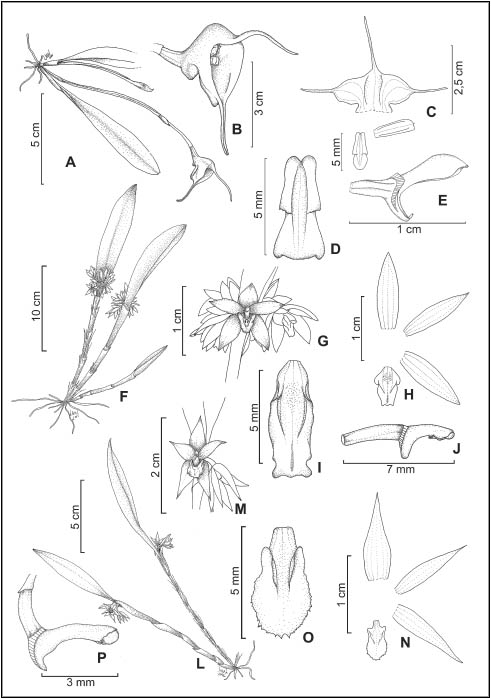 |
Fig. 2. A-E. Masdevallia infracta.
A: Habit. B: Flower. C: Dissected perianth. D: Labellum. E: Column and ovary. F-J. Octomeria alpina. F: Habit.
G: Flower. H: Dissected perianth. I: Labellum. J: Column and ovary. L-P. Octomeria diaphana. L: Habit. M: Flower. N: Dissected perianth. O: Labellum.
P: Column and ovary (A-E. Menini Neto et al. 173, F-J. Menini Neto et al. 138, L-P. Menini Neto et al. 111).
26043001 boletim.indd 258 04.12.07 14:30:51 |
Octomeria R. Br.
Rupicolous or epiphyte herb. Flattened, cylindrical or triquetrous leaves. Simple flowers, gathered in a fascicle which emerges laterally next to the ramicaule apex; sepals
in general similar, free, the lateral ones can partial or almost totally coalescent; big petals similar to the sepals; trilobed labellum with a pair of lamella in the disk, the base attached to the column foot; Cylindrical or semicylindrical column, with developed column foot, anther usually
subapical; ventral entire stigma; Pollinia 8, granulous caudicle, little developed (Luer 1986a).
Octomeria has about 150 species, extensively distributed all the neotropical region, with the majority concentrated in the southeast of Brazil (Luer 1986a). Pabst & Dungs
(1975) evaluated that about a hundred species are found in Brazil.
|
2. Octomeria alpina Barb. Rodr., Gen Sp. Orchid. 2: 102.
1881.
Fig. 2 F-J.
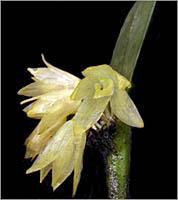 |
Examined material: Minas Gerais, Lima Duarte, PEIB, wood near to Lagoa Seca, IV.1994, fr., Forzza et al. 53 (CESJ); in wood of the Cavern of Pião, 9.III.2004, fl., Menini Neto et al. 138 (CESJ, R, RB); wood of the Cavern of Três Arcos, 9.III.2004, fl., Menini Neto et al. 140, (CESJ, R, RB).
Geographical distribution: Brazilian southeast and south regions (excepting for Rio Grande do Sul).
Octomeria alpina can be seen in many places of the Park, it is an epiphyte species of the interior or of the edges of the wood, rarely seen as rupicolous in rupestrian field. Although it is part of the group denominated by Pabst & Dungs (1975) as the Octomeria crassifolia Alliance, composed by difficult delimitation taxa, it is easily differentiated from the other species of the genus occurring the Park. There are more vigorous than the others, the ramicaules are thickest and the leaves are crass, the flowers are yellow (except for two atrovinaceous blotches on the lip), gathered in fascicles from 15 to 20 flowers. |
3. Octomeria diaphana Lindl., Edwards’s Bot. Reg. 25
(Misc.): 91. 1839.
Fig. 2 L-P.
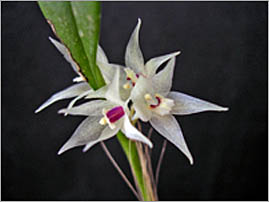 |
Examined material: Minas Gerais, Lima Duarte, PEIB, Mata
Grande, 12.III.1994, fr., Forzza 89 (CESJ); idem, 6.II.2004, fl./fr., Menini
Neto et al. 111 (CESJ, R, RB); idem, 19.III.2005, fl., Dias-Melo
et al. 213 (RB).
Geographical distribution: Minas Gerais, Rio de Janeiro,
Paraná and Santa Catarina.
Octomeria diaphana is an epiphyte species from the humid environments with medium luminosity. In the PEIB, it was found just in the Mata Grande, forming big population in the lower branches tree and also in fallen branches of the big trees, among mosses and other epiphytes. It can be distinguished from the other species mainly by presenting a delicate ramicaule covered by sheathes laterally compressed,
from 3 to 5 flowers per fascicle, with alba and acuminate petals. Forzza et al. (1994) and Menini Neto &
Forzza (2002) cited this taxon as O. aff. fialhoensis Dutra ex Pabst.
|
4. Octomeria grandiflora Lindl., Edwards’s Bot. Reg. 28:
64. 1842.
Fig. 3. A-E
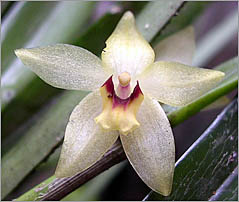 |
Examined material: Minas Gerais, Lima Duarte, Serra de Ibitipoca,
13.V.1970, fl., Krieger & Confúcio s.n. (CESJ 8603); idem,
2.XI.1973, fl., Krieger s.n. (CESJ 13196); PEIB, wood of the Cavern of
Três Arcos, 17.X.1993, fl., Forzza et al. 63 (CESJ); mata da Gruta do
Pião, 2.XII.2003, fl., Menini Neto & Alves 80 (CESJ); no located, 25.III.2001, fl., Heluey & Castro 107 (CESJ).
Geographical distribution: Suriname, Trinidad, Bolivia and
Paraguay. In Brazil, it occurs in Amazonas, Amapá, southeast and south regions (except for Espírito Santo and Rio Grande do Sul). Octomeria grandiflora is an epiphyte species, in the interior of the humid and shaded woods and had been seen in many points of the PEIB, mainly the areas above 1300
m altitude. Although O. alpina is the large species of Octomeria registered in the Park, O. grandiflora presents the longest ramicaules and leaves
among the species of the genus in the area, having as another distinct characteristics the foliar elliptic lamina, 1 to 3 flowers by fascicle and cream petals and sepals with round apex. |
|
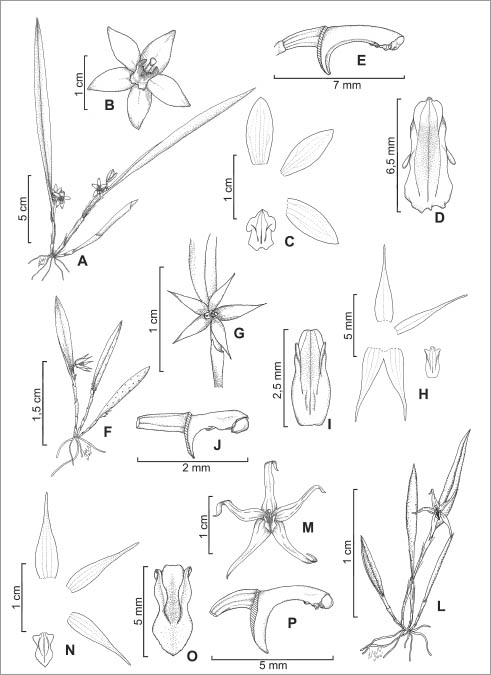 |
Fig. 3. A-E. Octomeria grandiflora.
A: Habit. B: Flower. C: Dissected perianth. D: Labellum. E: Column and ovary.
F-J. Octomeria aff. rubrifolia. F: Habit. G: Flower. H: Dissected perianth. I: Labellum.
J: Column and ovary. L-P. Octomeria wawrae. L: Habit. M: Flower.
N: Dissected perianth.
O: Labellum. P: Column and ovary.
(A-E. Menini Neto & Alves 80, F-J. Menini Neto et al. 40, L-P. Menini Neto et al. 168). |
5. Octomeria aff. rubrifolia Barb. Rodr., Gen. Spec. Orchid.
1: 31. 1877.
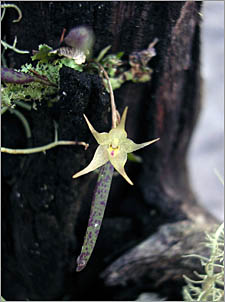 |
Geographical distribution: Minas Gerais.
O. rubrifolia e O. ochroleuca have been described by Rodrigues
(1877) who points out the affinity between both.
However the characteristics observed for the species here registered show as intermediate between the species described and illustrated by Rodrigues in the original description, mainly concerning the number of the flowers in the fascicle, the morphology of the labellum and the coalescence existing between the lateral sepals.
Thus, due to the necessity of doing a big study of this taxon, we preferred to adopt the affinity with one of the species, in this case aff. rubrifolia. |
6. Octomeria wawrae Rchb. f. ex Wawra, Itin. Princ. S.
Coburgi 2: 156. 1888.
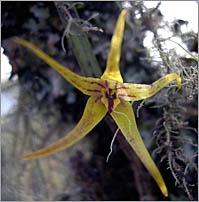 |
Examined material: Minas Gerais, Lima Duarte, PEIB, ciliary wood at the base of the Cavern of the Pião, 18.X.2003, fl./fr., Menini Neto et al. 24
(CESJ); candeia wood between the Casas dos Pesquisadores and the Ponte de
Pedra, 19.X.2003, fl., Menini Neto et al. 38 (CESJ, R); ciliary wood next to the Lago dos Espelhos (Mirros Lake) , 27.X.2004, fl., Menini Neto et al. 168 (R,
RB); without location, 25.VI.1987, fl., Sousa et al. s.n. (BHCB 15769);
idem, 29.V.1993, fl., Forzza & Salimena-Pires 41 (CESJ).
Geographical distribution: Brazilian southeast region (except for
Espírito Santo).
Octomeria wawrae is an epiphyte species from the interior and the edge of the wood, also occurring in the ciliary woods, in environments with a great or less amount of luminosity and humidity. In the PEIB, it was found in the ciliary woods and in candeia woods
It is distinguished from the other species of the genus registered for the Park by the semi-cylindrical leaves, 1-2 flowers per fascicle, golden-yellow vinaceous veined petals and sepals and the acuminate apex.
|
Pleurothallis R. Br. sensu lato
Epiphyte, rupicolous or terrestrial herbs. Prolific or not ramicaules, shorter or longer than the leaf, from round to laterally compressed or winged in the transversal section. Up-right leaf in comparison to the ramicaule, flattened, cylindrical or laterally compressed. Inflorescence laterally arising, bellow or in the layer of the abscission between the ramicaule and the leaf, with a solitaire flower, simple or fasciculate or in raceme, membranous to strong fleshy sepals, free or varied coalescent; membranous to strong fleshy petals, 1-3-lobed; membranous to strong fleshy labellum, smooth, callous, papilate, ciliate or fimbriate , 1-5-lobed, the base variably articulate with the base of the column or the apex of the column foot, sometimes inflexibility adnate; semicylindrical column, short or long, winged or not, with tooth or not, the base of the column developed or not in one foot with the apex of the ovary, the tip of the foot sometimes elongate beyond the ovary, apical to
ventral anther, concealed or exposed, stigma apical a ventral, 1-2lobed,
Pollinia 2, bare or with small tail, granulous, little developed (Luer 1986c).
Pleurothallis sensu lato presents neotropical distribution and shelters about 2000 species (Luer 1986a).
It is the biggest genus of epiphyte Angiosperms and one of the biggest in the Orchidaceae family (Atwood 1986; Luer 1986c; Gentry &
Dodson 1987). Pabst & Dungs (1975) cited about 300
species to Brazil, but due to the descriptions of new species, new registers and synonymization , this number is quite modified and needs to be revised. Due to the high number of taxa and to the great diversity of forms, its taxonomic history is quite controversial. Lindley (1859) already pointed out the necessity of segregating the genera but in reason of the small number of available material and insufficient knowledge by this time, it was impossible to be done.
Luer (1986a) affirms that “a Pleurothallis should be described as any Pleurothallidinae which does not fit well in any another genus ”. Pridgeon et al. (2001) showed that the genus is not monofiletic and Pridgeon & Chase
(2001) segregated Pleurothallis into 10 another genera. Luer (2002) pointed out many problems with the analyzes presented by those authors and did not accept the classification proposed. On the other hand, Luer (2004,
2006), did new combinations different from those presented by Pridgeon & Chase (2001). In face of those recent alterations and the incongruence in the taxonomy of the genus, the option adopted is Pleurothallis sensu lato, as recognized by Pabst & Dungs (1975).
|
7. Pleurothallis cryptophoranthoides Loefgr., Arch. Jard.
Bot. Rio de Janeiro 2: 52. 1918.
Fig. 4 A-E.
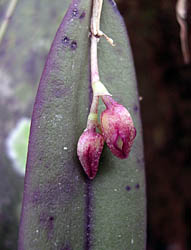 |
Examined material: Minas Gerais, Lima Duarte, PEIB, mata da
caixa d’água, 7.IV.1987, fl., Sousa s.n. (BHCB 16647); Mata Grande, fl.
cult. III.2005, fl., Menini Neto et al. 176 (CESJ, R, RB).
Geographical distribution: Brazilian southeast region.
Pleurothallis cryptophoranthoides is an epiphyte species, from the interior of the humid and shade wood.
It was found in the interior of the Mata Grande, forming clumps relatively big, in the trunk of a big tree, next to an flooded area in the wood.
It can be easily differentiated even when sterile for being a pendent plant, with asymmetrical, discolor leaves which are dark green in the adaxial face and atro-lilacineas in the abaxial face, with revolute edges.
Its flowers arise from a short inflorescence with up to 4 flowers, vinaceous color and cream shaded. They do not open completely due to the conivent disposition of the sepals apex, allowing just two small lateral apertures, in the same way as the flowers of the genus Cryptophoranthus. |
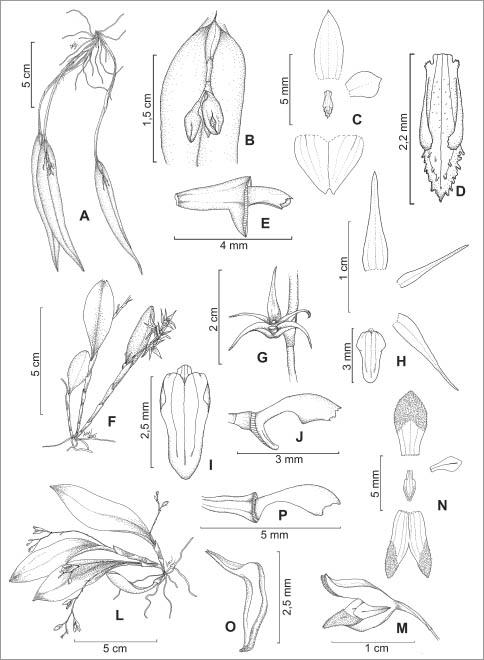 |
Fig. 4. A-E. Pleurothallis cryptophoranthoides
A: Habit. B: Flower. C: Dissected perianth. D: Labellum. E: Column and ovary.
F-J. Pleurothallis
heterophylla. F: Habit. G: Flower. H: Dissected perianth. I: Labellum.
J: Column and ovary. L-P. Pleurothallis hypnicola. L: Habit. M: Flower.
N:
Dissected perianth. O: Side view of the labellum. P: Column and Ovary
(A-E. Menini Neto et al. 176, F-J. Menini Neto et al. 177, L-P. Menini Neto
et al. 134). |
8. Pleurothallis heterophylla (Barb. Rodr.) Cogn. in
Mart., Fl. bras. 3(4): 556. 1896.
Fig. 4 F-J.
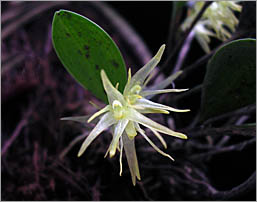 |
Examined material: Minas Gerais, Lima Duarte, PEIB, wood in front of the the Casas dos Pesquisadores (Researches houses), fl. cult. VIII.2004, fl., Menini Neto
et al. 177 (CESJ, R); no location , 26.IV.1988, fl., Andrade & Drummond
1160 (BHCB).
Geographical distribution: Minas Gerais, Rio de Janeiro,
Espírito Santo, São Paulo and Paraná.
Pleurothallis heterophylla is an epiphyte species, in the interior
of the wood, occurring in the high humid and relatively shade places. In the PEIB, it has been registered in ciliary wood, in the edges of the rivers and brooks, together with the mosses and another epiphyte. This is a plant apparently rare in the area, just a small clump has bee seen. It distinguishes from the other species of the genus occurring the in Park by the smaller or the same size inflorescence as the leave, big flowers
if compared if the plant size, with the floral segments in a disposition similar to a star. |
9. Pleurothallis hypnicola Lindl., Edwards’s Bot. Reg.
28: 75. 1842.
Fig. 4 L-P.
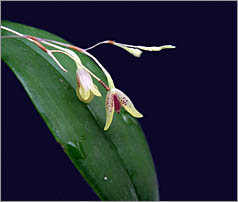 |
Examined material: Minas Gerais, Lima Duarte, PEIB, Mata
Grande, 09.III.2004, fl./fr., Menini Neto et al. 134 (CESJ, R, RB); idem,
30.VI.2004, fl./fr., Assis et al. 1054 (RB).
Geographical distribution: Brazilian southeast and south regions.
Pleurothallis hypnicola is an epiphyte species, occurring in a great variety of environments: rainy forests, capões (island wood) in rupestrian fields, ciliary woods, semidecidual woods and restinga (sandbank) woods. In the PEIB, it has been seen just in the Mata Grande,
in more or less shaded humid areas, forming big clumps in broken trunks or on the branches and trunks of the smaller trees. It is distinguished from the other species of genus in the area
by the ramicaule shorter than the foliar lamina, leaves with a caniculate base, flexuous inflorescence with successive opening of the flowers . Pleurothallis hypnicola is often identified in the herbaria as Pleurothallis cuneifolia Cogn., considered as a synonym by Pabst & Dungs (1975). |
10. Pleurothallis johannensis Barb. Rodr., Gen. Sp. Orchid.
2: 23. 1881.
Fig. 5 A-E.
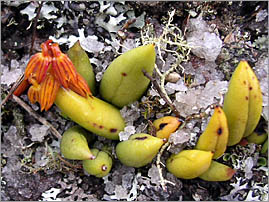 |
Examined material: Minas Gerais, Lima Duarte, Serra de Ibitipoca,
3.XI.1973, Krieger s.n. (CESJ 13217); PEIB, no location ,
3.IV.1993, fr., Forzza et al. 11 (CESJ); idem, 12.XI.1993, fl.,
Forzza et al. 70 (CESJ); idem, 8.II.1996, fr., Rodela Q2-24 (CESJ);
idem, 1.XII.2003, fl., Menini Neto & Alves 45 (CESJ, R, RB); idem, 20.XII.2003, fl., Menini Neto & Ferreira 81 (CESJ).
Geographical distribution: Minas Gerais.
Pleurothallis johannensis is a rupicolous species which forms great populations in the outcrops of the rupestrian fields,
found practically in all PEIB,
but it occurs less often over 1500 m
altitude. This is the most easy species to be differentiated among the Pleurothallis species occurring in the PEIB, in view of being rupicolous and presenting cylindrical and fleshy leaves, which color varies since the yellow-greenish until the atro-vinaceous. Its flowers are fleshy, unpleasant scent, arising from upright inflorescence smaller or a little higher than the leaves. Forzza et al. (1994) cited the species as Pleruothallis. teres Lindl. |
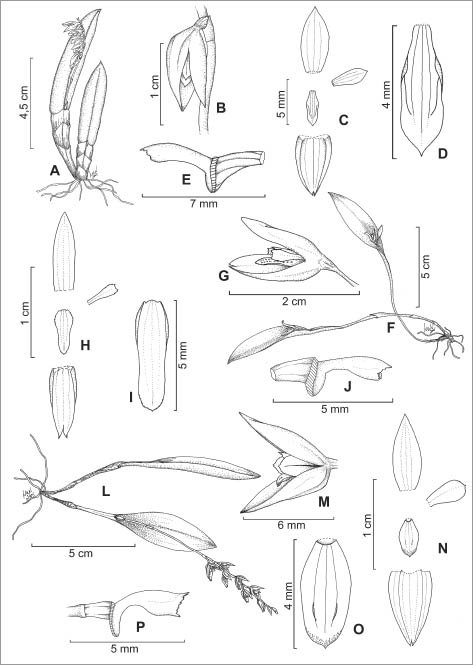 |
Fig. 5. A-E. Pleurothallis johannensis
A: Habit. B: Flower. C: Dissected perianth. D: Labellum. E: Column and ovary.
F-J. Pleurothallis luteola. F: Habit. G: Flower. H: Dissected perianth. I: Labellum.
J: Column and ovary. L-P. Pleurothallis malachantha. L: Habit. M: Flower.
N: Dissected perianth. O: Lateral view of the labellum. P: Column and ovary
(A-E. Menini Neto & Ferreira 81, F-J. Menini Neto et al. 158,
L-P. Menini Neto &
Ferreira 90).
|
11. Pleurothallis luteola Lindl., Edwards’s Bot. Reg. 27:
1. 1841.
Fig. 5 F-J.
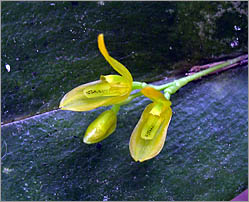 |
Geographical distribution: South and southeast regions of Brazil
Pleurothallis luteola is an epiphyte species occurring in humid and shaded places, in general in ciliary woods, next to sources of water.
In the PEIB, it has been registered only to the interior of the Mata Grande (Big Wood).
It can be distinguished from the other species of Pleurothallis of the PEIB mainly by the ramicaule
laterally compressed and caniculate in the third superior, by the short inflorescence, 1-2-flora, resting in the base of the leaf and with two lines of small vinaceous spots on the lip.
Often identified in the herbaria as P. caespitosa Barb.
Rodr., name considered as synonym (Pabst & Dungs -1975). |
12. Pleurothallis malachantha Rchb. f., Bonplandia 3:
223. 1855.
Fig. 5 L-P.
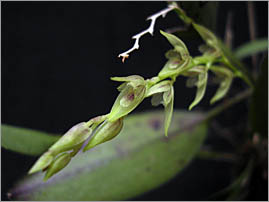 |
Examined material: Minas Gerais, Lima Duarte, PEIB, wood next to Portaria (entrance), 21.XII.2003, fl., Menini Neto & Ferreira 90 (CESJ, R);
no location, 17.II.1987, fl., Sousa s.n. (BHCB 9832).
Geographical distribution: Minas Gerais, Rio de Janeiro and
Paraná.
Pleurothallis malachantha is an epiphyte species from the interior of the wood found, in the PEIB, next to the base of the trunks of the tree, among another epiphyte.
It is distinguished from the other species of Pleurothallis registered to the Park mainly by the ramicaule sheathes which are vinaceous blotched, by the apex of the triangular section ramicaule and by the cream-greenish and vinaceous veined flowers. |
13. Pleurothallis marginalis Rchb. f., Bonplandia 3: 224.
(1855).
Fig. 6 A-E.
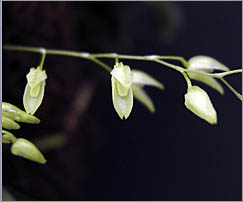 |
Examined material: Minas Gerais, Lima Duarte, PEIB, Mata
Grande, fl. cult. X.2004, fl., Menini Neto et al. 162 (CESJ, R, RB).
Geographical distribution: Brazilian southeast and south regions.
Pleurothallis marginalis is an epiphyte species, preferentially in humid and shade places. In the Park it has been found just in the interior of the
Mata Grande, forming big clumps in the thin branches of the small trees, among the moss. It can be distinguished from the other species of Pleurothallis registered in the Park due to the small size and by the flexuous inflorescence with the simultaneous cream-greenish flowers. This species is often identified in the herbaria as a variety of Pleurothallis
grobyi Bateman ex Lindl. However, some characteristics, in spite of the affinity, allow its distinction: The size of P. marginalis is always shorter than P. grobyi, as well the length and the number of the flowers in its inflorescence and by the size of the flowers. Another characteristic which distinguishes them is the presence of two vinaceous strips in the dorsal sepal and two in the lip in P. grobyi, and lacking in Pleurothallis
marginalis. |
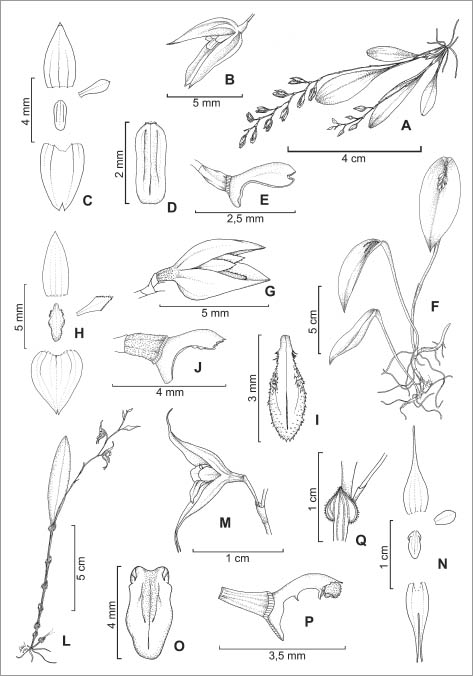 |
Fig. 6. A-E. Pleurothallis marginalis.
A: Habit. B: Flower. C: Dissected perianth. D: Labellum.
E: Column and ovary.
F-J. Pleurothallis modestissima. F: Habit.
G: Flower. H: Dissected perianth.
I: Labellum.
J: Column and ovary.
L-Q. Pleurothallis quartzicola. L: Habit.
M: Flower.
N: Dissected perianth.
O: Labellum. P: Column and ovary.
Q: Detail of the ramicaule sheath
(A-E. Menini Neto et al. 162, F-J. Menini Neto & Ferreira 85,
L-Q. Menini Neto et al. 114). |
14. Pleurothallis modestissima Rchb. f., Otia Bot. Hamburg.:
93. 1881.
Fig. 6 F-J.
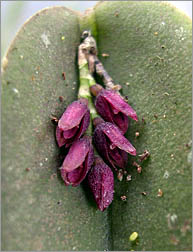 |
Examined material: Minas Gerais, Lima Duarte, PEIB, base da
Lombada, 1.XII.2003, bot., Menini Neto & Alves 51 (CESJ, R); trail at the side of the road between the Portaria (entrance) and the Centro de Informações (information center),
21.XII.2003, fl., Menini Neto & Ferreira 85 (CESJ, R); no located,
25.VI.1987, fl., Sousa et al. s.n. (BHCB 16691); idem, 17.IV.1993, fl./ fr., Forzza & Brügger 19 (CESJ).
Geographical distribution: Minas Gerais.
Pleurothallis modestissima can be found in many places of the Park, in the transition of the wood to the rupestrian field, in general in humid places.
It is distinguished from the other species of the genus found in the area by being the only saxicolous of reptant habit, by the leaves in general cordate, by the inflorescence appressed to the leaves and by the vinaceous flowers. This species is part of a group of very similar species,
together with P. prolifera Herb. ex Lindl., P. hamosa Barb. Rodr.
and P. limae Porto & Brade, from those, it is distinguished, as its names suggests, by the smaller size of the plant and smaller size of the flowers. However the relations and identities of the taxa of this group are not very clearly, claiming for a better study in the delimitation of the species.
Forzza et al. (1994), Andrade & Sousa (1995) and Menini Neto & Forzza (2002) cited this species as Pleurothallis prolifera. |
15. Pleurothallis quartzicola (Barb. Rodr.) Cogn. in
Mart., Fl. bras. 3(4): 581. 1896.
Fig. 6 L-Q.
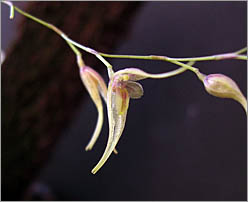 |
Pleurothallis quartzicola is an epiphyte species found in the interior
of the wood.
In the PEIB, it has been seen only in the Mata Grande,
near to the contiguous edge of the Matinha (Small wood), on the small tree, among moss and lichens.
It is seems to be rare, due to the smaller number registered collected in the herbaria.
It is distinguished from the other species of Pleurothallis in the Park, mainly by the set of lepanthiform chestnut sheathes covering all the ramicaule, by the flexuous Inflorescence and fleshy leaf, smaller than the ramicaule. |
16. Pleurothallis recurva Lindl., Edwards’s Bot. Reg. 27
(Misc.): 1. 1841.
Fig. 7 A-E.
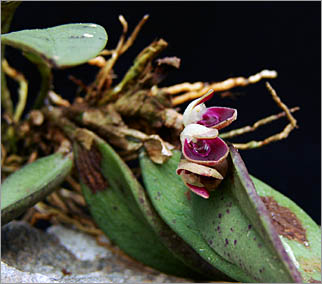 |
Examined material: Minas Gerais, Lima Duarte, PEIB, Mata
Grande, fl. cult. XI.2006, fl., Menini Neto et al. 237 (CESJ).
Geographical distribution: Brazilian southeast and south regions.
Pleurothallis recurva is a species from the interior of the wood.
In the PEIB it has been seen just in the Mata Grande.
It is distinguished from the other species of Pleurothallis from the Parque
mainly by the form of growing appressed to the substrate, toward the base of the phorophyte, short inflorescence, with several simultaneous flowers and lateral sepals totally
coalescent.
|
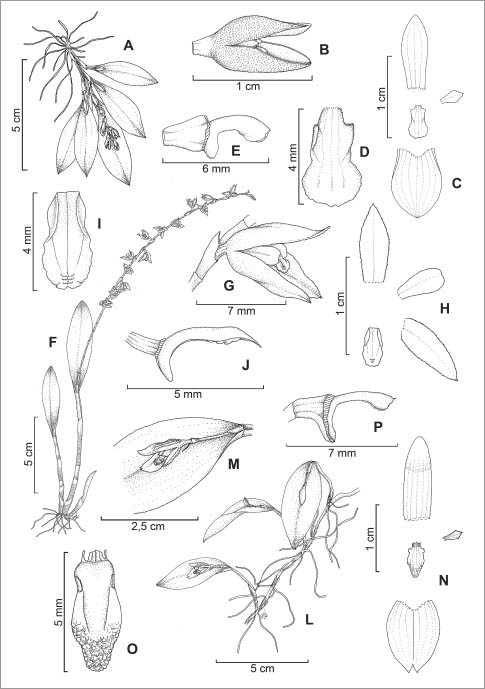 |
Fig. 7. A-E. Pleurothallis recurva
A. Habit. B: Flower. C: Dissected perianth. D: Labellum. E. Column and ovary.
F-J. Pleurothallis rubens. F: Habit.
G: Flower. H: Dissected perianth. I: Labellum.
J: Column and ovary. L-P. Pleurothallis saundersiana. L: Habit. M: Flower.
N: Dissected perianth. O: Labellum. P: Column and ovary.
(A-E. Menini Neto et al. 237, F-J. Menini Neto et al. 31, L-P. Menini Neto et al. 37). |
17. Pleurothallis rubens Lindl., Edwards’s Bot. Reg. 21:
t. 1797. 1835.
Fig. 7 F-J.
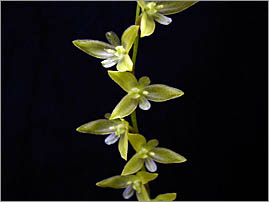 |
Examined material: Minas Gerais, Lima Duarte, PEIB, next to the Cavern of Pião, fl. cult. XII.2003, fl., Menini Neto et al. 31 (CESJ,
R); Trail Monjolinho-Lagoa Seca, 29.VI.2004, fr., Assis et al. 1033
(RB); no located, 20.I.1987, fl., Sousa s.n. (BHCB 16157); idem,
28.II.1993, fl., Forzza 78 (CESJ).
Geographical distribution: Pernambuco, Bahia and states of the Brazilian southeast and south regions.
Pleurothallis rubens is a species predominantly epiphyte, found in a great variety of habitats,
since the rupestrian fields until the humid woods. It is frequent in the PEIB, being seen in the rupestrian field and in the edges and interior of the woods, always as epiphyte. It is the most vigorous plant of the Pleurothallis species registered to the Park, it is also differentiated from the other by the long inflorescence of yellow flowers, which exceeds the length of the leaf. |
18. Pleurothallis saundersiana Rchb. f., Gard. Chron.
1866: 74. 1866.
Fig. 7 L-P.
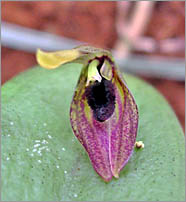 |
Examined material: Minas Gerais, Lima Duarte, Serra de Ibitipoca,
5.VII.1975, fl., Krieger s.n. (CESJ 13679); PEIB, between the Centro de
Informações (Information Center) and Ponte de Pedra, 18.X.2003, fr., Menini Neto et al. 37
(CESJ); in the wood next to the road between the Portaria (entrance) and the Centro de Informações ,
9.III.2004, fl., Menini Neto et al. 121 (CESJ, R); no located, 15.V.1993, fl., Forzza 32 (CESJ).
Geographical distribution: Bolivia, Peru and Brazil (Bahia and southeast and south regions)
Pleurothallis saundersiana is an epiphyte species, found in a great variety of habitats: ciliary woods,
island of wood (capões de mata), in the rupestrian woods, rainforests and restinga (sandbank) wood.
In the PEIB forms big population in the branches and the trunks of trees, in the island of wood (capões de mata).
It can be distinguished from the other species of Pleurothallis of the Park by being the only one epiphyte species which presents a reptant habit and by having the 1-flora inflorescence. Often it is found in the herbaria identified as P. josephensis Barb. Rodr., name considered as simony (Pabst & Dungs 1975). |
19. Pleurothallis tricarinata Poepp. & Endl., Nov. Gen.
Sp. Pl. 1: 49. 1836.
Fig. 8 A-E.
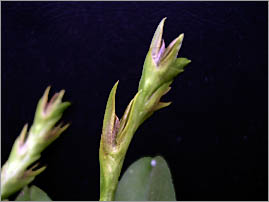 |
Geographical distribution: Ecuador, Bolivia, Peru and Brazil (southeast region and Paraná).
Pleurothallis tricarinata is an epiphyte species, from the interior
of the wood, being frequently found the ciliary woods.
In the PEIB it occurs only in the interior of the Mata Grande
next to the extremity contiguous edge of the Matinha (Small wood), forming clumps in the trunk of small trees, among mosses and lichens.
It can be distinguished by the others species of Pleurothallis from the Park due to the its ramicaules, inflorescence and flowers
strongly compressed laterally, besides to have sepals with very developed keels.
Often found in the herbaria identified as P. platystachys Regel, name considered as simony by Luer (2004). |
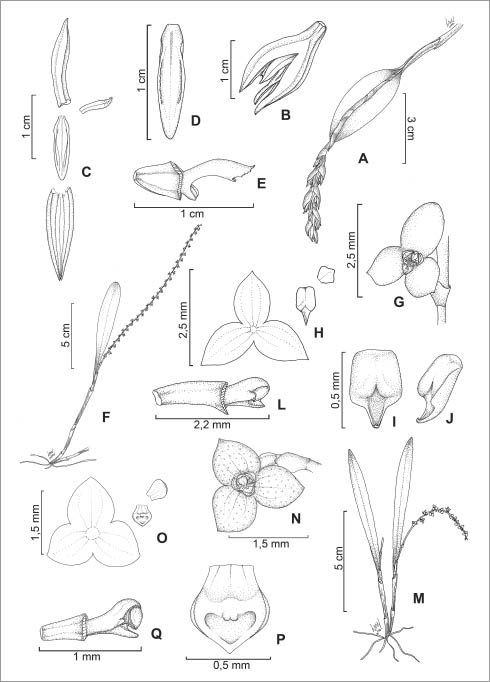 |
Fig. 8. A-E. Pleurothallis tricarinata.
A: Habit. B: Flower. C: Dissected perianth. D: Labellum. E: Column and ovary.
F-J. Stelis aprica. F: Habit. G: Flower. H: Dissected perianth. I: Labellum.
J: Lateral view of the labellum. L: Column and ovary. M-Q. Stelis intermedia. M: Habit.
N: Flower. O: Dissected perianth. P: Labellum. Q: Column and ovary.
(A-E. Menini Neto et al. 434, F-L. Menini Neto et al. 127, M-Q. Menini Neto et al. 159). |
Stelis Sw.
Epiphyte or saxicolous herb. Leaves often narrowed at the base forming a pseudopetiole. Inflorescence in raceme, always multiflora , arising from the ramicaule apex, next to the base of the leaves; flowers in general quite reduced; sepals conate in a big or small degree, often forming a triangular synsepal; petals usually very small, with thick edges, laterally disposed to the column and to the labellum; labellum usually very small, fleshy;
Short and wide column; Apical anther and stigma, stigma
in general bilobed, pollinia 2, granulous caudicle, little developed (Garay 1979; Luer 1986a).
Stelis is a genus with wide distribution in tropical America and shelters about 500 species (Luer 1986a). The flowers
of the majority of the species are quite characteristic,
the sepals are united at the base, in a big or small degree, forming a synsepal relatively flat, with a form next to a triangle, having in the central regions the petals and labellum, often very small. However with the proposition done by Pridgeon & Chase (2001) which separated Pleurothallis, many species classified in this genus
were allocated under Stelis, modifying the characters which define it, position not adopted in this work.
The most complete work done with Stelis is the one by
Garay (1979) where taxonomical treatment and illustrations of the flowers are presented in an expressive percentage of the species. Pabst & Dungs (1975) mentioned about 60 species
to Brazil, but due to the synonyms cited by Garay (1979), this number must be revised. |
20. Stelis aprica Lindl., Companion Bot. Mag. 2: 353.
1836.
Fig. 8 F-L.
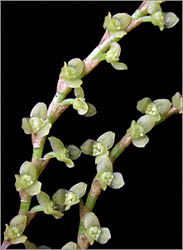 |
Examined material: Minas Gerais, Lima Duarte, Serra de Ibitipoca,
12.V.1970, fr., Krieger s.n. (CESJ 8593); PEIB, in the wood of the Pião, 9.III.2004, fl., Menini Neto et al. 127 (CESJ, R, RB).
Geographical distribution: Tropical America.
Stelis aprica is an epiphyte species occurring in the interior of the wood, in high humid and medium enlightened environments.
In the Park it has been seen in the nebular woods, forming clumps in the lower branches of the tree, next to another epiphyte.
It can be distinguished from the other species de Stelis registered to the PEIB by the narrow oblongate leaves, very long inflorescence bearing up to 70 light-green very small flores with trilobed labellum and medial triangular lob.
It is often found in the herbaria identified as S. catharinensis Lindl., name considered as simony by Garay
(1979). |
21. Stelis intermedia Poepp. & Endl., Nov. Gen. Sp. Pl.
1: 46. 1836.
Fig. 8 M-Q.
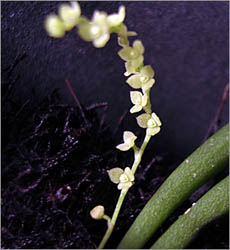 |
Geographical distribution: Pabst & Dungs (1975) cited Stelis intermedia for the north of South America, Minas Gerais
and Rio de Janeiro.
Garay (1979) put in the synonymies of S. intermedia two species accepted as distinct by
Pabst & Dungs (1975), S. drosophila Barb. Rodr. and S. dusenii Garay.
In this way, the distribution of the S. intermedia in the Brazilian territory should be modified to include the distribution assigned to this synonyms, spreading it to the other states of the Brazilian southeast and south regions.
Stelis intermedia is an epiphyte species, occurring in the interior of the rain forests, ciliary woods or resting woods.
In the PEIB it has been registered in the interior of the
Mata Grande, with the other epiphyte in the fallen branch of tree.
It is distinguished from the another species by the linear leaves and bended inflorescence, with about 20 light-green flowers. |
22. Stelis megantha Barb. Rodr., Gen. Sp. Orchid. 2: 83.
1881.
Fig. 9 A-E.
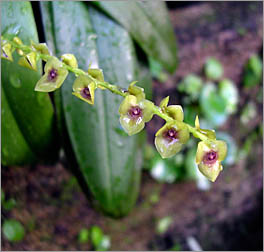 |
Examined material: Minas Gerais, Lima Duarte, PEIB, Mata
Grande, III.1994, fl., Forzza et al. 60 (CESJ); idem, 30.III.2004, fl.,
Menini Neto et al. 148 (CESJ, R).
Geographical distribution: Brazilian southeast and south regions.
Stelis megantha is an epiphyte species, in the interior of the wood,
growing in shade and high humid environments.
In the PEIB, it ha been found only in the interior of the Mata Grande and the contiguous edge of the Matinha, forming big clumps, often close to the water sources. It is distinguished from the other species of Stelis occurring in the PEIB by the vigorous size and by the flowers which fit well with the name as they are among the biggest found in the genus. Often found in the herbaria identified as S. macrochlamys Hoehne & Schltr., name considered as simony by Pabst & Dungs
(1975) e Garay (1979). |
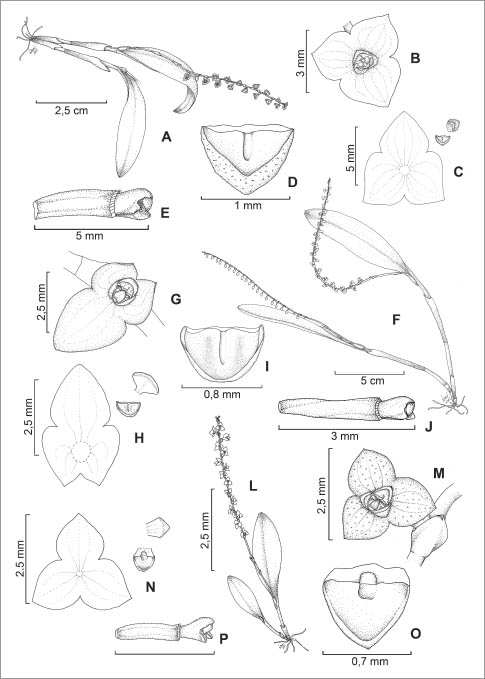 |
Fig. 9. A-E. Stelis megantha.
A: Habit. B: Flower. C: Dissected perianth. D: Labellum. E: Column and ovary.
F-J. Stelis parquetries. F: Habit. G: Flower. H: Dissected perianth. I: Labellum.
J: Column and ovary. L-P. Stelis parvula. L: Habit. M: Flower. N: Dissected perianth.
O: Labellum. P:
Column and ovary
(A-E. Menini Neto et al. 148, F-J. Menini Neto et al. 157, L-O. Menini Neto & Laves 78). |
23. Stelis parquetries. Chub. lf., Linage 22: 822.
1849.
Fig. 9 F-J.
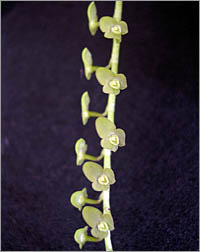 |
Examined material: Minas Gerais, Lima Duarte, PEIB, Mata
Grande, fl. cult. V.2004, fl., Menini Neto et al. 157 (CESJ, R, RB).
Geographical distribution: Pabst & Dungs (1975) cited this species for the states of Amazon as, Pernambuco
and Minas Gerais, besides Venezuela. However, Garay
(1979) attributed many synonyms to Stelis parquetries., in a way that the distribution in the Brazilian territory is bigger than that presented by Pabst & Dungs (1975), including the states of the southeast (except for Espírito Santo) and the south regions of the country.
Stelis parquetries. occurs as epiphyte, in the interior of the humid and shade woods.
In the PEIB it has been registered in the interior of the Mata Grande, together with another epiphyte in the branches of the smaller trees.
It presents long Inflorescence bearing from
20 to 30 light-green flowers, with the dorsal sepal which form and shape are different from the lateral sepals |
24. Stelis parvula Lindl., Folia Orch. 8: 7. 1879.
Fig. 9 L-P.
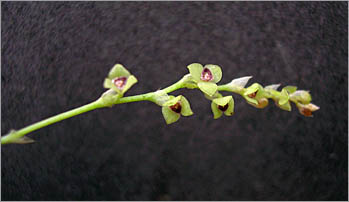 |
Examined material: Minas Gerais, Lima Duarte, PEIB, wood of the Cavern of Três Arcos, X.1994, bot., Forzza et al. 64 (CESJ); wood of the Cavern of Monjolinho, X.1994, bot., Forzza et al. 52 (CESJ); idem,
18.X.2003, bot., Menini Neto et al. 25 (CESJ); mata da Gruta do Pião, 2.XII.2003, fl., Menini Neto & Alves 78 (CESJ, R, RB).
Geographical distribution: Early only cited to Mexico and Central America (World Checklist of Monocots
2004), S. parvula was cited to Brazil by Toscana de Briton (1995). The examined material in the herbaria also inform that besides Bahia, this species also occurs in Rio
de Janeiro and Minas Gerais.
Stelis parvula is an epiphyte species, occurring in the interior and in the edge of the nebular wood in high humid environments with medium luminosity. It has been seen in many places of the Park always above 1400m altitude. |
It is distinguished from the other species of Stelis in the Park by the reduced size, being the smallest species of the genus in the area, detached floral sheathes, big in proportion to the flowers, flowers with light-green to yellow sepals and vinaceous petals and labellum.
Toscana de Briton
(1995) did the first register of this species to Brazil and affirmed that the specimens from the Pico das Almas are identical to the type-material of S. parvula. The examined material from the Park is according to cited materials and with the description presented in the referred flora (Harley et al.
26924), also being similar to the illustration presented by Garay (1979) for the species. Besides de material collected in the Park, some indeterminate collections deposited in the herbaria are also very similar to the material of the Pico das Almas. Forzza et al. (1994) cited this species as Stelis sp. and Menini Neto & Forzza (2002) cited as Stelis drosophila. |
Acknowledges
To IEF-MG, specially to the direction and the employees of the Park for all support and encouragement for the development of this work. To FAPERJ for the scholarship granted to the first author (processo E-26/151779/2003). To the researchers
Fábio de Barros, Marcus Nadruz and Andrea Costa and to an anonymous reviser for the precious suggestions.
References
ALVES, R.J.V. 1991. Guia de campo das orquídeas da Serra de São
José, MG, Brazil. Tropicaleaf.
ANDRADE, P.M. & SOUSA, H.C. 1995. Contribuição ao conhecimento
da vegetação do Parque Estadual de Ibitipoca, Lima Duarte,
Minas Gerais. Revista Árvore 19(2): 249-261.
ATWOOD, J.T. 1986. The size of the Orchidaceae and the systematic
distribution of the epiphytic orchids. Selbyana 9: 171-186.
BARROS, F. 1996. Notas taxonômicas para as species Brazileiras dos
genus s Epidendrum, Platystele, Pleurothallis e Scaphyglottis (Orchidaceae).
Acta Bot. Bras. 10(1): 139-151.
CARVALHO, L.M.T., FONTES, M.A. & OLIVEIRA FILHO, A. 2000.
Tree species distribution in canopy gaps and mature Forest in an
area of cloud Forest of the Ibitipoca Range, south-eastern Brazil.
Plant Ecol. 149: 9-22.
CETEC. 1983. Diagnóstico ambiental de Minas Gerais. CETEC. Belo
Horizonte.
CHRISTENSON, E. 2004. Orchidaceae. In: N. Smith, S. Mori, A. Henderson,
D.W. Stevenson & S.V. Heald (eds) Flowering Plants of
Neotropics. Princeton University Press. Princeton, p. 465-468.
COGNIAUX, A. 1893-1896. Orchidaceae. In C.F.P. Martius, A.G. Eichler & I. Urban (eds.). Flora Braziliensis Frid. Fleischer. Leipzig,
vol. 3, pars 4, p. 1-672.
CORRÊA NETO, A.V. 1997. Cavernas em quartzitos da Serra do Ibitipoca,
sudeste de Minas Gerais. In G.C. Rocha (coord.) Anais do
1º Seminário de Pesquisa sobre o Parque Estadual de Ibitipoca.
Núcleo de Pesquisa em Zoneamento Ambiental da UFJF. Juiz de
Fora, p. 51-60.
DRESSLER, R.L. 1993. Phylogeny and Classification of the Orchid
Family. Dioscorides Press. Portland.
DRUMMOND, G.M., MARTINS, C.S., MACHADO, A.B.M, SEBAIO,
F.A. & ANTONINI, Y. (orgs). 2005. Biodiversidade em
Minas Gerais, um atlas para sua conservação. ed. 2. Fundação
Biodiversitas. Belo Horizonte. FERREIRA, M.B. & MAGALHÃES, G.M. 1977. Contribuição para o conhecimento da vegetação da Serra do Espinhaço em Minas
Gerais (Serras de Grão Mogol e da Ibitipoca). In Anais do XXVI
Congresso Nacional de Botânica, 1975. Academia Brazileira de
Ciências. Rio de Janeiro, p. 189-202.
FONTES, M.A.L. 1997. Análise da composição florística das florestas
nebulares do Parque Estadual de Ibitipoca, Minas Gerais. Dissertação
de Mestrado. Universidade Federal de Lavras.
FORZZA, R.C., BARROS, F. & SALIMENA-PIRES, F.R. 1994. Orchidaceae
do Parque Estadual de Ibitipoca, Minas Gerais (checklist).
Principia 1: 125-136.
GARAY, L.A. 1979. Systematics of the genus Stelis. Bot. Mus. Leafl. 27: 167-259.
GENTRY, A.H. & DODSON, C.H. 1987. Diversity and biogeography
of neotropical vascular epiphytes. Ann. Missouri Bot. Gard. 74:
205-233.
GIULIETTI, A.M., MENEZES, N.L., PIRANI, J.R., MEGURO, M. &
WANDERLEY, M.G.L. 1987. Flora da Serra do Cipó, Minas Gerais:
caracterização e lista das species. Bol. Bot. Univ. São Paulo 9: 1-151.
HARLEY, R.M. & SIMMONS, N.A. 1986. Florula of Mucugê: Chapada
Diamantina – Bahia, Brazil. Royal Botanic Gardens. Kew.
HOLMGREN, P.K., HOLMGREN, N.H. & BARNETT, L.C. 1990. Index
Herbariorum: the herbaria of the world. New York Botanical
Garden. New York.
LINDLEY, J. 1859. Pleurothallis. Folia Orchidacea. J. Mathews. London.
LUER, C.A. 1978. Dryadella, a new genus in the Pleurothallidinae (Orchidaceae). Selbyana 2: 207-209.
LUER, C.A. 1986a. Icones Pleurothallidinarum I. Systematics of
the Pleurothallidinae (Orchidaceae). Monographs in Systematic
Botany from the Missouri Botanical Garden 15. Saint
Louis.
LUER, C.A. 1986b. Icones Pleurothallidinarum II. Systematics of
Masdevallia (Orchidaceae). Monographs in Systematic Botany
from the Missouri Botanical Garden 16. Saint Louis.
LUER, C.A. 1986c. Icones Pleurothallidinarum III. Systematics of Pleurothallis (Orchidaceae). Monographs in Systematic Botany
from the Missouri Botanical Garden 20. Saint Louis.
LUER, C.A. 2002. A systematic method of classification of the Pleurothallidinae versus a strictly phylogenetic method. Selbyana 23(1):
57-110.
LUER, C.A. 2004. Icones Pleurothallidinarum XXVI. Systematics of Pleurothallis subgenus Acianthera and three allied subgenera;
A second century of new species of Stelis of Ecuador; Epibator, Ophidion, Zootrophion. Monographs in Systematic Botany from
the Missouri Botanical Garden 95. Saint Louis.
LUER, C.A. 2006. Icones Pleurothallidinarum XXVIII, A Reconsideration
of Masdevallia; Systematics of Specklinia and Vegetatively
Similar Taxa. Monographs in Systematic Botany from the Missouri
Botanical Garden 105. Saint Louis.
MENINI NETO, L. & FORZZA, R.C. 2002. Orquídeas do Parque Estadual
de Ibitipoca. Boletim CAOB 48: 35-40.
MILWARD-DE-AZEVEDO, M.A. 2007. Passifloraceae do Parque Estadual
de Ibitipoca, Minas Gerais. Bol. Bot. Univ. São Paulo 25(1):
71-79.
PABST, G.F.J. & DUNGS, F. 1975. Orchidaceae Brazilienses. Band I.
Kurt Schmersow. Hildesheim.
PERON, M.V. 1989. Listagem preliminar da flora fanerogâmica dos
campos rupestres do Parque Estadual do Itacolomi – Ouro Preto/
Mariana, MG. Rodriguésia 67(41): 63-69.
PIRANI, J.R., GIULIETTI, A.M., MELLO-SILVA, R. & MEGURO, M. 1994. Checklist and patterns of geographic distribution of the
vegetation of Serra do Ambrósio, Minas Gerais, Brazil. Revta. Brazil.
Bot. 17(2): 133-147.
PIRANI, J.R., MELLO-SILVA, R. & GIULIETTI, A.M. 2003. Flora
de Grão-Mogol, Minas Gerais, Brazil. Bol. Bot. Univ. São Paulo
21(1): 1-24.
PRIDGEON, A.M. 1982. Numerical analyses in the classification
of the Pleurothallidinae (Orchidaceae). Bot. J. Linn. Soc. 85:
103-131.
PRIDGEON, A.M. & CHASE, M.W. 2001. A phylogenetic reclassification
of Pleurothallidinae (Orchidaceae). Lindleyana 16(4):
235-271.
PRIDGEON, A.M., SOLANO, R. & CHASE, M.W. 2001. Phylogenenetic
relationships in Pleurothallidinae (Orchidaceae): Combined
evidence from nuclear and plastid DNA sequences. Amer. J. Bot.
88(2): 2286-2308.
RODELA, L.C. 1998. Cerrados de altitude e campos rupestres do Parque
Estadual de Ibitipoca, sudeste de Minas Gerais: distribuição e
florística por subfisionomias da vegetação. Revta Depart. Geografia
USP 12: 163-189.
RODRIGUES, J.B. 1877. Genera et Species Orchidearum Novarum.
vol. I. Typographia Nacional. Rio de Janeiro.
RODRIGUES, J. B. 1882. Genera et Species Orchidearum Novarum.
vol. 2. Typographia Nacional. Rio de Janeiro.
SAINT-HILAIRE, A.F.C. 1822. Segunda viagem do Rio de Janeiro a
Minas Gerais e São Paulo. (Trad. Vivaldi Moreira, 1974). Ed. Itatiaia.
Belo Horizonte/ EDUSP. São Paulo.
SALIMENA-PIRES, F.R. 1997. Aspectos fisionômicos e vegetacionais
do Parque Estadual de Ibitipoca, Minas Gerais, Brazil. In G.C.
Rocha (coord) Anais do 1º Seminário de Pesquisa sobre o Parque
Estadual de Ibitipoca. Núcleo de Pesquisa em Zoneamento Ambiental
da UFJF. Juiz de Fora, p. 51-60.
SILVEIRA, A.A. 1928. Floralia Montium. vol 2. Imprensa Official.
Belo Horizonte.
STANNARD, B.L. (ed) 1995. Flora of the Pico das Almas – Chapada
Diamantina, Bahia, Brazil. Royal Botanic Gardens.
Kew.
TOSCANO-DE-BRITO, A.L.V. 1995. Orchidaceae. In B.L. Stannard
(ed.) Flora of the Pico das Almas – Chapada Diamantina, Bahia,
Brazil. Royal Botanic Gardens. Kew, p. 725-767.
URBAN, I. 1906. Vitae Itineraque Collectorum Botanicorum, Notae
Collaboratorum Biographicae, Florae Braziliensis Ratio Edendi
Chronologica, Systema, Index Familiarum. In C.F.P. Martius, A.G.
Eichler & I. Urban (eds.) Flora Braziliensis. Frid. Fleischer. Leipzig,
vol. 1, pars. 1, p. 1-487.
VITTA, F. 2002. Diversidade e conservação da flora nos campos rupestres
da Cadeia do Espinhaço em Minas Gerais. In E.L. Araújo,
A.N. Moura, E.V.S.B. Sampaio, L.M.S. Gestinari & J.M.T. Carneiro
(eds.) Biodiversidade, conservação e uso sustentável da flora do
Brazil. UFRPE / SBB. Recife, p. 90-94.
WORLD CHECKLIST OF MONOCOTS 2004. The Board of Trustees
of the Royal Botanic Gardens, Kew. Published on the Internet;
http://www.kew.org/monocotChecklist/ (acessado em 26 de maio de
2005).
ZAPPI, D.C., LUCAS, E., STANNARD, B.L., NIC-LUGHADHA, E.,
PIRANI, J.R., QUEIROZ, L.P., ATKINS, S., HIND, D.J.N., GIULIETTI,
A.M., HARLEY, R.M. & CARVALHO, A.M. 2003. Lista
das plantsvasculares de Catolés, Chapada Diamantina, Bahia,
Brazil. Bol. Bot. Univ. São Paulo 21(2): 345-389.
* Departamento de Botânica, ICB, Universidade Federal de Juiz de Fora, Campus Universitário, Bairro Martelos, 36036-090 -
Juiz de Fora, MG, Brazil. menini_neto@hotmail.com.
** Departamento de Botânica, Museu Nacional, Quinta da Boa Vista, s.n., São Cristóvão, 20940-040 - Rio de Janeiro, RJ, Brazil.
*** Jardim Botânico do Rio de Janeiro, Rua Pacheco Leão 915, 22460-030 - Rio de Janeiro, RJ, Brazil.
Photos: Luiz Menini Neto
|
|































